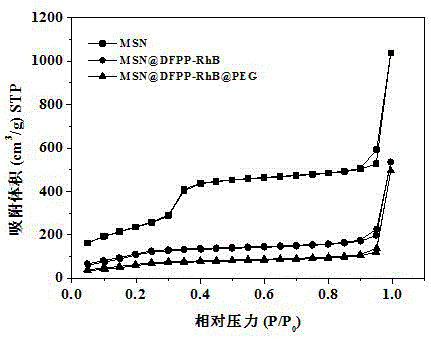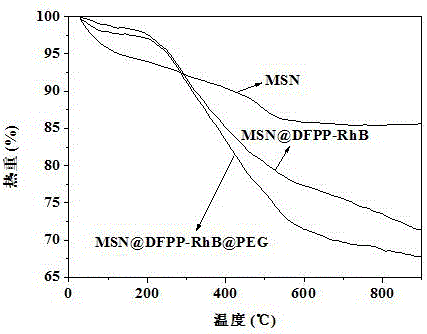Hybridization probe for fluorescent detection of copper ions in water phase and preparation method thereof
A fluorescence detection, copper ion technology, applied in chemical instruments and methods, fluorescence/phosphorescence, measurement devices, etc., can solve problems such as poor water solubility, inability to detect copper traces in aqueous phase and intracellular fluorescence imaging, etc. The effect of few steps, high sensitivity and mild reaction conditions
- Summary
- Abstract
- Description
- Claims
- Application Information
AI Technical Summary
Problems solved by technology
Method used
Image
Examples
Embodiment 1
[0025] Example 1: Preparation and characterization of hybrid nanoprobe MSN@DFPP-RhB@PEG.
[0026] (1) Dissolve 0.05~0.50 g cetyltrimethylammonium bromide (CTAB) and 0.02~0.10 g triethanolamine (TEA) in 20 mL of pure water, and then heat to 95°C for reaction. After reacting for 1 to 2 hours, add 1.5 to 5 mL of ethyl orthosilicate to the reaction system, continue to react for 1 to 2 hours after the dropwise addition is complete, and centrifuge to wash to obtain a white solid. After that, the white solid was dissolved in ethanol by rapid ion exchange method, and then 0.1 g~1.0 g NH dissolved in it was added 4 NO 3 The ethanol solution is heated and reacted for 2~4 h, and finally the white solid is washed and dried to obtain mesoporous silica nanosphere MSN.
[0027] (2) Add the mesoporous silica nanospheres and 3-isocyanatopropyltriethoxysilane obtained in the above step (1) to the toluene solution in a mass ratio of 30:1-10:1, Heat to reflux for 12-24 h, centrifuge the obtained prod...
Embodiment 2
[0034] Example 2: Preparation of hybrid nanoprobe MSN@RH101@PEG.
[0035] (1) Dissolve 0.05~0.50 g cetyltrimethylammonium bromide (CTAB) and 0.02~0.10 g triethanolamine (TEA) in 20 mL of pure water, and then heat to 95°C for reaction. After reacting for 1 to 2 hours, add 1.5 to 5 mL of ethyl orthosilicate to the reaction system, continue to react for 1 to 2 hours after the dropwise addition is complete, and centrifuge to wash to obtain a white solid. After that, the white solid was dissolved in ethanol by rapid ion exchange method, and then 0.1 g~1.0 g NH dissolved in it was added 4 NO 3 The ethanol solution is heated and reacted for 2~4 h, and finally the white solid is washed and dried to obtain mesoporous silica nanosphere MSN.
[0036] (2) Add the mesoporous silica nanospheres and 3-isocyanatopropyltriethoxysilane obtained in the above step (1) to the toluene solution in a mass ratio of 30:1-10:1, Heat to reflux for 12-24 h, centrifuge the obtained product and wash it with eth...
Embodiment 3
[0041] Example 3: Detection of copper ion by hybrid nanoprobe MSN@DFPP-RhB@PEG.
[0042] (1) Weigh the hybrid fluorescent nanoprobe MSN@DFPP-RhB@PEG prepared in Example 1, and make it into a 1.0 mg / mL aqueous solution.
[0043] (2) Prepare concentrated solutions (0.1M) of various metal ions, including Na + , K + , Mg 2+ , Ca 2+ , Ba 2+ , Zn 2+ , Li + , Mn 2 + , Co 2+ , Hg 2+ Wait, and the ion to be detected Cu 2+ .
[0044] (3) In the selectivity experiment, a certain equivalent of various metal ions were added to 2.0 mL of the hybrid fluorescent nanoprobe aqueous solution, and then the absorption spectrum and fluorescence spectrum were tested. The results are shown in the attachment respectively. Figure 4 And Figure 5 .
[0045] (4) In the titration experiment, use a pipette to draw 2.0 mL of the hybrid fluorescent nanoprobe aqueous solution and place it in a 1.0 cm×1.0 cm quartz cuvette, and use a micro-injector to sequentially add Cu to the solution 2+ The solution is tested for u...
PUM
| Property | Measurement | Unit |
|---|---|---|
| pore size | aaaaa | aaaaa |
| pore size | aaaaa | aaaaa |
Abstract
Description
Claims
Application Information
 Login to View More
Login to View More - R&D
- Intellectual Property
- Life Sciences
- Materials
- Tech Scout
- Unparalleled Data Quality
- Higher Quality Content
- 60% Fewer Hallucinations
Browse by: Latest US Patents, China's latest patents, Technical Efficacy Thesaurus, Application Domain, Technology Topic, Popular Technical Reports.
© 2025 PatSnap. All rights reserved.Legal|Privacy policy|Modern Slavery Act Transparency Statement|Sitemap|About US| Contact US: help@patsnap.com



